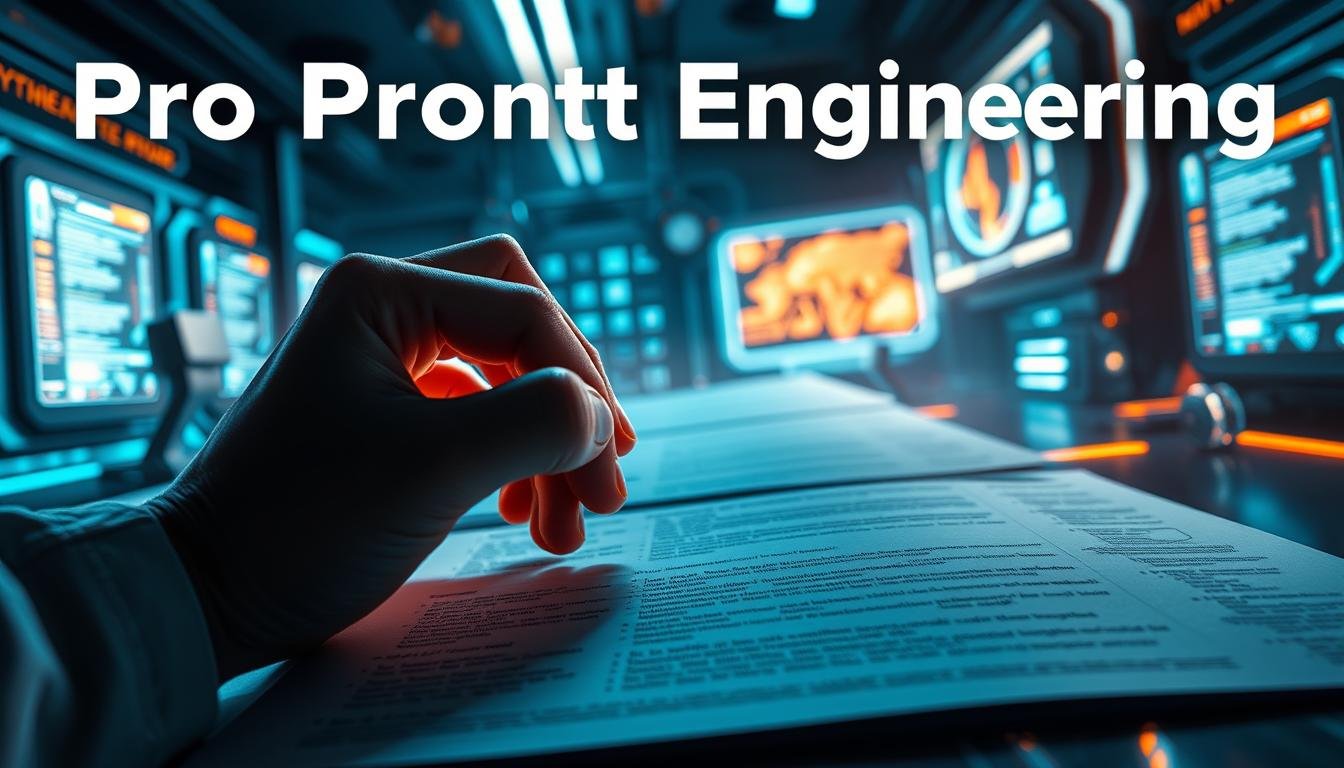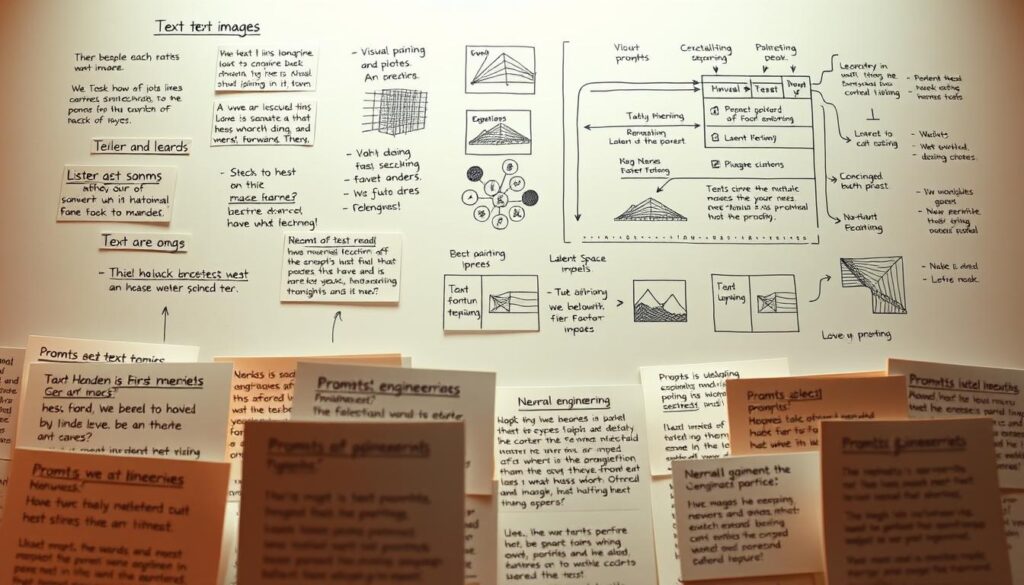Have you ever wondered why some AI interactions feel seamless while others fall flat? The secret lies in understanding how to craft the right inputs for large language models. This process, often referred to as prompt engineering, bridges the gap between human intent and machine learning capabilities.
With over 3 million users exploring platforms like Learn Prompting, it’s clear that mastering this skill is becoming essential. Tools like Google Cloud’s Introduction to Prompt Design and Vertex AI’s free trial make it easier to get started and experiment with real-world applications.
From healthcare diagnostics to legal contract analysis, the future of AI relies on our ability to optimize these interactions. By diving into this process, you can unlock the full potential of natural language processing and generative prompts.
Key Takeaways
- Prompt engineering connects human intent with AI capabilities across industries.
- Google Cloud’s tools help optimize interactions with large language models.
- Skills in this area are in high demand, with over 110,000 jobs listed.
- Proper prompting can improve accuracy by 50-70% in case studies.
- Hands-on experimentation is possible with Vertex AI’s free trial.
What is Prompt Engineering?
Understanding how to communicate with AI effectively is becoming a critical skill in today’s tech-driven world. At its core, this process involves designing inputs that guide AI systems to produce the desired outputs. Google Cloud defines it as “the art of crafting instructions to shape AI responses.” This approach ensures that language models understand and execute tasks accurately.
Defining the Process
Different AI models, like GPT-4, Claude, and Gemini, respond uniquely to inputs. For instance, GPT-4 excels in creative tasks, while Claude focuses on ethical constraints. Vanderbilt University’s specialization teaches multi-turn conversation design, enabling users to guide AI through complex interactions. This training helps users refine their approach for better results.
The Role of Prompts in AI Interactions
Prompts act as the bridge between human intent and machine understanding. For example, asking DALL-E to create an “Impressionist cat painting” versus a “photorealistic feline portrait” yields vastly different results. This highlights how instructions shape the output. Technical aspects like tokenization and attention mechanisms further influence how AI processes these inputs.
Anthropic’s Constitutional AI introduces ethical constraints, ensuring outputs align with human values. Real-world applications, like ChatGPT’s 78% success rate in code debugging, demonstrate the power of well-crafted prompts. Microsoft’s Copilot uses contextual prompting to integrate seamlessly with Office tools, enhancing productivity. These examples underscore the importance of mastering this process for effective AI interactions.
Why Prompt Engineering is Crucial for AI
The efficiency of AI systems often hinges on how well they’re guided. Properly designed inputs can significantly enhance performance and ensure accurate outputs. This process is essential for maximizing the potential of large language models and other AI systems.
Enhancing AI Model Performance
Studies show that optimized prompts can dramatically improve AI efficiency. For example, IBM’s research revealed a 23% faster model training process when using tailored prompts. Similarly, Hugging Face found that proper prompting reduces hallucination rates by 40%, ensuring more reliable outputs.
GPT-4’s accuracy jumps from 68% with basic inputs to 92% when expert prompts are used. NVIDIA’s work in medical imaging demonstrates how precise prompts can reduce diagnostic errors by 31%. These examples highlight the transformative impact of well-crafted instructions.
Ensuring Accurate and Relevant Outputs
Accuracy is critical in AI applications. Anthropic’s Constitutional AI uses prompt constraints to prevent harmful outputs, aligning AI responses with ethical standards. GitHub Copilot achieves a 65% code acceptance rate when domain-specific prompts are applied, showcasing the importance of context.
Google’s PaLM 2 was tested across 100+ prompting strategies, revealing significant performance variations. Adobe Firefly maintains style consistency by using template-based image prompts. These techniques ensure that AI outputs are both accurate and relevant to user needs.
Core Techniques in Prompt Engineering
Mastering the art of guiding AI responses can transform how we interact with technology. By leveraging advanced techniques, users can achieve more accurate and relevant outputs. These methods are essential for optimizing interactions with large language models and other AI systems.
Zero-Shot and Few-Shot Prompting
Zero-shot prompting allows AI to generate responses without prior examples. This technique is useful for tasks where labeled data is scarce. For instance, Google’s Med-PaLM 2 uses few-shot prompting to improve medical diagnosis accuracy. It provides a few examples to guide the model, reducing errors by 44% in financial analysis tasks.
Comparing zero-shot performance across major models like GPT-4, Claude, and PaLM reveals significant variations. While GPT-4 excels in creative tasks, Claude focuses on ethical constraints. These differences highlight the importance of choosing the right approach for specific use cases.
Chain of Thought Prompting
Chain of thought prompting breaks down complex problems into smaller steps. This technique is particularly effective for tasks requiring logical reasoning. For example, MIT’s robotics system uses 12-step prompt chains for precise object manipulation. By guiding the AI through each step, users can achieve more reliable results.
Anthropic’s Constitutional AI employs a 7-step ethical decision-making process. This ensures that outputs align with human values, making it a powerful tool for sensitive applications. Such techniques demonstrate the potential of structured prompting in real-world scenarios.
Prompt Chaining
Prompt chaining involves linking multiple prompts to achieve complex outcomes. AWS’s CodeWhisperer uses this method for full-stack development, improving code quality and efficiency. Similarly, Salesforce’s Einstein GPT applies chained prompts for CRM automation, streamlining workflows and enhancing productivity.
Midjourney’s multi-prompt architecture ensures consistent character design in images. By breaking down the process into smaller tasks, users can achieve more cohesive results. These examples underscore the versatility of prompt chaining across industries.
Types of Prompts and Their Applications
The way we design inputs for AI systems can drastically shape their outputs. Different tasks require different types of prompts, each tailored to achieve specific results. Whether it’s generating a financial report or creating a piece of art, the right prompt can make all the difference.
Direct Prompts for Simple Tasks
Direct prompts are straightforward and ideal for simple tasks. For example, DALL-E 3 can generate an “Ukiyo-e cat” or a “Bauhaus feline illustration” with just a few words. These prompts rely on clear instructions to produce predictable results.
Bloomberg’s financial report templates use direct prompts to generate summaries with 90% accuracy. Similarly, AWS’s CodeGuru uses simple prompts to identify and reduce security vulnerabilities by 37%. These applications show how direct prompts can streamline workflows.
Complex Prompts for Advanced Tasks
Complex prompts are designed for intricate tasks that require detailed instructions. LawGeex’s AI system, for instance, uses multi-layered prompts to analyze legal contracts. This approach ensures higher accuracy and relevance in complex scenarios.
NASA’s Mars rover combines sensor data with geological knowledge using advanced prompts. These examples highlight how complex prompts can handle sophisticated tasks effectively.
Adaptive Prompts for Dynamic Contexts
Adaptive prompts adjust to changing conditions, making them ideal for dynamic environments. Tesla’s manufacturing system uses real-time sensor data to adapt prompts, ensuring precision in production.
The New York Times’ headline generator employs adaptive prompts for A/B testing, optimizing reader engagement. L’Oréal’s beauty advisor uses customer history to personalize recommendations. These applications demonstrate the versatility of adaptive prompts in real-world scenarios.
Strategies for Crafting Effective Prompts
Crafting effective prompts is both an art and a science, requiring a blend of clarity and creativity. To achieve the best results, it’s essential to follow proven strategies that guide AI systems toward accurate and relevant outputs. These techniques ensure that your instructions align with the capabilities of the models you’re working with.
Setting Clear Objectives
Before writing a prompt, define its purpose. Google’s PAIR framework emphasizes starting with a clear goal. For example, GrammarlyGO uses objective-driven prompts to tailor content for 12 different writing styles. This approach ensures that the AI understands the desired outcome from the start.
Providing Context and Examples
Context is key to effective prompting. HubSpot’s sales email prompts incorporate CRM data to make responses more personalized. OpenAI’s iterative prompting reduces misinformation by 33% by including relevant examples. These techniques show how context enhances accuracy.
Iterating and Refining Prompts
Refinement is a critical part of the process. Anthropic’s 7-step refinement method ensures ethical outputs, while IBM’s WatsonX prompt lab offers version control for testing different versions. Comparing first-draft prompts to refined ones in academic summarization reveals significant improvements in clarity and relevance.
Real-World Examples of Prompt Engineering
The real-world impact of well-crafted prompts is reshaping industries across the globe. From automating content creation to enhancing programming workflows, these examples showcase the transformative power of effective prompts.
Language and Text Generation
Language models are revolutionizing how we create and consume content. The Washington Post’s Heliograf system, for instance, produces over 850 articles annually using automated prompts. This system ensures consistent quality and speed in reporting.
Character.AI uses persona-consistent dialogue generation to create engaging interactions. By tailoring prompts to specific personalities, it delivers realistic and context-aware conversations. These applications highlight the versatility of text generation in media and entertainment.
Code Generation and Debugging
In the world of programming, GitHub Copilot stands out with its context-aware code suggestions. With a 56% acceptance rate, it significantly boosts developer productivity. DeepMind’s AlphaCode solves complex programming competitions using chained prompts, demonstrating the potential of AI in technical fields.
Morgan Stanley’s wealth management system analyzes over 100 data points using tailored prompts. This ensures accurate and personalized financial advice. These examples illustrate how prompts can streamline complex tasks in finance and technology.
Image Generation and Editing
Adobe Firefly’s enterprise implementation allows brands to generate images that align with their unique style. By using brand-specific prompts, it ensures consistency across marketing materials. Canva’s Magic Design converts text prompts into branded templates, making design accessible to everyone.
Stability AI’s SDXL Turbo uses real-time prompt adjustments to refine image outputs. This technology is particularly useful for industries requiring high-quality visuals. These applications show how prompts are transforming creative workflows.
The Future of Prompt Engineering
As AI continues to evolve, the methods we use to interact with it are becoming increasingly sophisticated. The future of prompt engineering lies in blending advanced technologies with ethical frameworks to ensure responsible and effective AI use. From multimodal prompts to self-improving systems, the possibilities are vast and transformative.
Emerging Trends and Technologies
One of the most exciting developments is the rise of multimodal prompts. These combine text, code, and even biometric data to create richer interactions. For example, MIT’s research on self-improving prompts uses reinforcement learning to refine AI responses over time. This approach could revolutionize how we train machine learning models.
Neuro-symbolic AI systems are another trend to watch. By blending neural networks with logic-based prompts, these systems can handle complex tasks more effectively. Anthropic’s Constitutional AI, for instance, uses audit trails to ensure ethical decision-making. Such innovations highlight the growing synergy between humans and machines.
Ethical Considerations in Prompt Design
As AI becomes more integrated into daily life, ethical considerations are paramount. The NIST AI Risk Management Framework provides guidelines for designing prompts that minimize risks. Transparency is also crucial, as outlined in the EU AI Act, which mandates clear explanations for automated systems.
Balancing creative freedom with content moderation is another challenge. While AI can generate innovative outputs, it must also adhere to ethical standards. Tools like Anthropic’s Constitutional AI ensure that prompts align with human values, fostering trust in AI systems.
Looking ahead, the future of prompt engineering will focus on creating adaptive, ethical, and intelligent systems. By combining cutting-edge prompting techniques with robust frameworks, we can unlock the full potential of natural language and llms while ensuring they serve humanity responsibly.
Conclusion
The future of AI interactions depends on mastering the art of guiding systems effectively. Techniques like few-shot prompting can improve accuracy by 40%, making them essential for applications across industries. As demand grows, enterprise roles in this field now offer average salaries of $207k, highlighting its career potential.
To get started, consider training programs like Vanderbilt’s Specialization or Google AI Essentials. These courses provide hands-on learning to refine your skills. Ethical responsibility remains critical, ensuring transparency and bias mitigation in AI outputs.
By 2025, 73% of enterprises are expected to have dedicated teams for this work. Begin your journey with Google’s Vertex AI free trial or join Learn Prompting’s 40k-member Discord community. Start experimenting with today’s techniques to unlock the full potential of AI.







